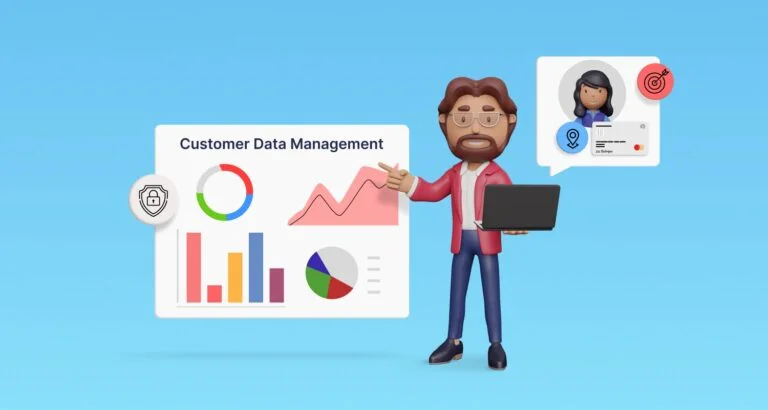In today’s data-driven world, businesses collect massive amounts of customer data to improve products and make smarter decisions. But here’s the problem: many rely on faulty or incomplete data. Simply collecting information isn’t enough; effective customer data management is the real challenge.
This is why robust customer data management, including strong privacy protections and compliance measures, is crucial for businesses to mitigate the risk of cyberattacks.
In this article, we’ll explore what customer data management means, why it’s essential for your business, and the best practices you can follow to turn raw data into real value.
What is customer data management?
Customer data management (CDM) is the process by which companies collect, organize, store, and secure customer information.
Customer data management aims to harness technology in gathering customer data and converting it into useful customer profiles.
These customer profiles can then assist in:
- Understanding the types of customers their behavior, and preferences
- Executing targeted digital marketing campaigns
- Delivering personalized experiences
Categories of customer data
Customer data encompasses more than just names and email addresses. Understanding the kinds of customer data available is key. This understanding enables you to utilize this data effectively to enhance your business. The following are the types of customer data:
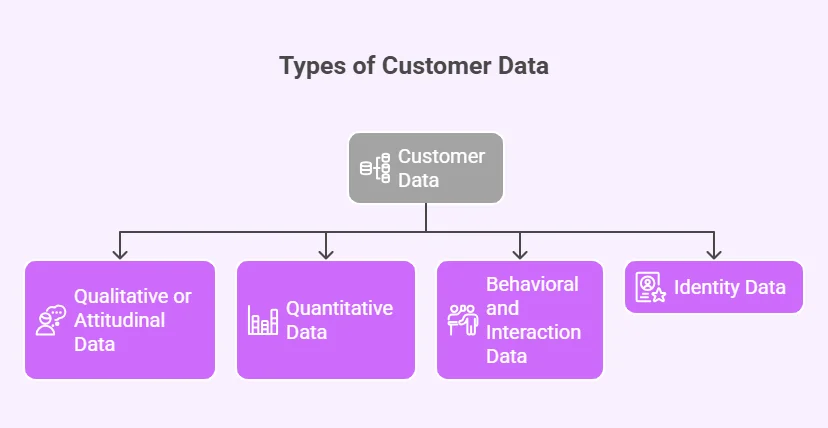
Identity data
This is data that identifies customers as unique individuals. Basic customer data includes a customer’s name, age, date of birth, phone number, postal and email addresses, gender, and race.
Basic customer data could also include customer’s:
- Profession and industry
- Income
- IP address
- Social media usernames
Basic data is unique and facilitates the creation of personalized products and services.
Data sources: This type of data can be gathered through your website by utilizing web forms that customers fill out.
These forms may include newsletter subscriptions, contact forms, account sign-ups, and purchases.
Behavioral and interaction data
This is data on how your clients interact with your business at different touchpoints.
Customer interaction data could include:
- Number and duration of website/app visits
- Click-through and bounce rates
- The total number of conversions
- The level of user engagement with ads, social media posts, videos, and emails
- The buying history of the customer
- The value of product orders, renewals, or cancellations of subscriptions
This type of data is important in gaining a deeper understanding of the various customer interactions and objectives throughout their experience with your company.
Data sources: Businesses utilize reports and analytic dashboards that give a rundown on how well their websites, ads, and social media campaigns are performing.
Behavioral data can also be gathered directly from your website by examining transactional information on products and individual user behavior.
Quantitative data
This is measurable data on the performance and shortcomings of business operations. This could include things like customer service statistics, online/offline transaction figures, and campaign measurements.
Data sources: This data can be sourced from help desk solutions, Google Analytics, marketing automation tools, and customer relationship management systems.
Qualitative or attitudinal data
Consists of direct customer opinions about your business, services, and products. It’s a bit more complex to process because instead of numbers, attitudinal data comprises:
- Reviews from customers and clients
- Responses to online surveys
- Face-to-face customer interactions
- Word-of-mouth reviews
Data sources: Customer opinions can be gathered through surveys and feedback forms that you distribute to your clients.
Steps to implementing a customer data management process
Let’s delve into the steps involved in implementing an effective customer data management process.
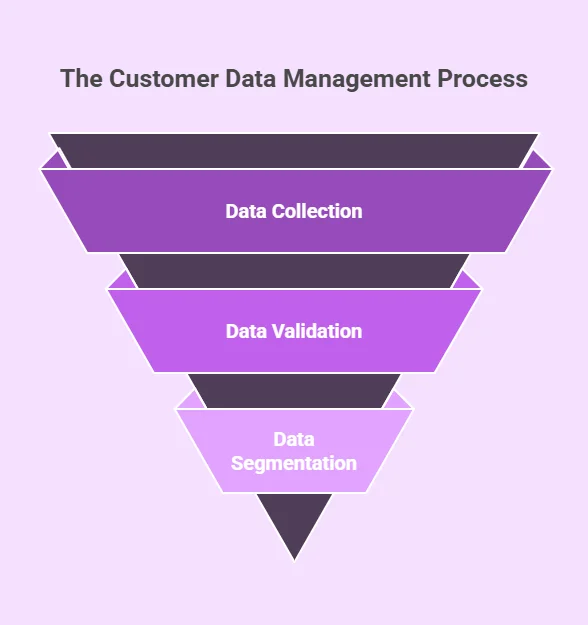
Data collection
The initial step involves setting up systems for gathering your customer data from a variety of channels. Develop a consolidated database for accumulating and storing the collected data.
Data validation
Data validation involves checking and verifying that the data entered into the database is accurate, correct, and usable. You can set up procedures to verify and improve its quality to prepare it for processing.
Data segmentation
Data segmentation involves creating unique and identifiable data clusters that define how the data can be used.
Use effective data segmentation tools and methods to develop comprehensive customer profiles that can be accessed as needed across departments.
What are the benefits of customer data management?
Effective customer data management aids in making well-informed decisions that significantly promote the success of a business.
Other benefits of customer data management include:
- High-quality data: By implementing data cleaning technology and techniques, you can ensure that the data you store is accurate and ready for processing.
- Improved customer satisfaction: Managing customer data makes it more suitable for analytics, which helps companies understand customer needs more accurately.
- Effective marketing campaigns: In sorting customer data into profiles, data management allows marketing teams and tech to analyze their demographics and create targeted campaigns.
- Improved customer trust: Proper data management fosters customer trust by ensuring that collected information is stored securely, maintained accurately, and used responsibly.
Customer data management best practices
Implementing top-notch tactics for handling customer data not only aids your business in efficiently utilizing the data but also reassures your customers of their privacy rights being respected.
Consider these best practices as a roadmap for effective management of customer data:
Statista reported that consumers found the privacy of their personal data was the issue of highest concern when interacting with companies in 2022.
It is, therefore, crucial to implement a customer data management strategy that keeps tabs on customer data throughout the pipeline to address these concerns.
You can start off by setting standards, guidelines, and goals to organize your efforts and effectively measure success at each stage.
The strategy should include information on:
- The people to manage the different aspects of the process
- A standardized way of data collection
- The data sources to be used
- Data storage locations
- Data governance and quality control measures
- The measures to ensure compliance with federal and internal regulations
Regular data cleansing is crucial for preserving the relevance and usefulness of your customer data. Routinely check, correct, or remove corrupt, inaccurate, or irrelevant parts of the data to enhance its quality and accuracy.
By doing so, you ensure that the data you rely on for customer understanding and decision-making is current and reliable.
Consumers are increasingly becoming aware and concerned about their data’s misuse. The impacts of a data breach have also become more severe.
IBM currently estimates the average cost of a data breach at USD $4.45 million, a 15% increase over the last 3 years.
Ensure data governance and security measures are in place to safeguard customer information from unauthorized access, use, disclosure, alteration, or destruction, right from the data collection stage. You can achieve this by implementing robust security practices, such as encryption, access controls, secure storage, and regular audits.
Collaborate with your legal team to confirm that the data platform you use complies with the law and that customers are well-informed about their data collection, usage, and sharing practices.
Not only is protecting customer privacy a legal requirement under data protection laws like the European Union’s General Data Protection Regulation (GDPR), but it also helps build customer trust.
Managing customer data can involve a lot of manual procedures, which could result in a significant workload for your in-house teams.
Investing in the right technology, like help desk software or a customer relationship management tool, provides an easy and secure way to collect, organize, and use customer data to enhance customer service strategies.
Additionally, it can also help you:
- Analyze customer data
- Record every customer interaction
- Automate tasks such as marketing email distribution and lead follow-ups
Another benefit is that these tools have the capacity to handle a larger amount of data as your business expands.
Always be intentional about the data you collect not only to save time and money but also to prevent your team and data platform from becoming overwhelmed.
Use a systematic approach to the data collection process to reduce irrelevant data. For instance, if you need a customer’s age, is it necessary to also collect their date of birth? If one piece of information suffices, there’s no need to gather both.
It’s one thing to have protocols and policies, but it’s another to ensure employees understand them. Train all staff who handle and manage data to follow the correct processes and methods.
For example, maintaining uniform data entry procedures can boost data quality, and being aware of possible security risks can improve data safety.
Remember to conduct recurring courses and update training to keep pace with any changes and technological advancements.
Find out more about data entry opportunities to expand your understanding of data management practices.
It’s important to have secure and updated backup systems to guarantee data recovery in the event of a data loss. Regularly test your backup systems to ensure they always step up when needed.
The following are some great tips for backing up data:
- Implement the 3-2-1 rule: A widely recommended strategy is the 3-2-1 backup rule:
- Have at least 3 copies of your data
- Store them on 2 different types of media
- Keep 1 copy offsite (e.g., cloud storage, a physically separate location)
- Automate backup processes: Manual backups are prone to human error and inconsistency. Implement automated backup solutions that run on a regular schedule (daily, hourly, or even continuously, depending on the criticality of the data)
In the past, businesses often held their customer data in separate silos, with each department having its own set of customer data.
This led to data inconsistencies, duplications, and inhibited a comprehensive understanding of customer behaviors.
By consolidating data from various channels into one central place, you can:
- Eliminate errors
- Centrally update and manage data
- Ensure that everyone has the same information
- Gain a more holistic view of the customer journey
- Enhance collaboration and efficiency
Transparency serves as a cornerstone of fostering trust and enhancing the reputation of a business.
Openly communicate on how you plan to collect, store, process, and utilize customer data.
This way, you can assure your customers about your ethical position and dedication to safeguarding their personal information, possibly drawing in more customers who greatly appreciate data privacy.
How does BoldDesk assist customer service teams in data management?
BoldDesk® is a sophisticated customer data platform that offers innovative features and tools to effectively gather, organize, analyze, and derive valuable insights from customer data.
Here’s how BoldDesk helps customer service teams manage and use their data:
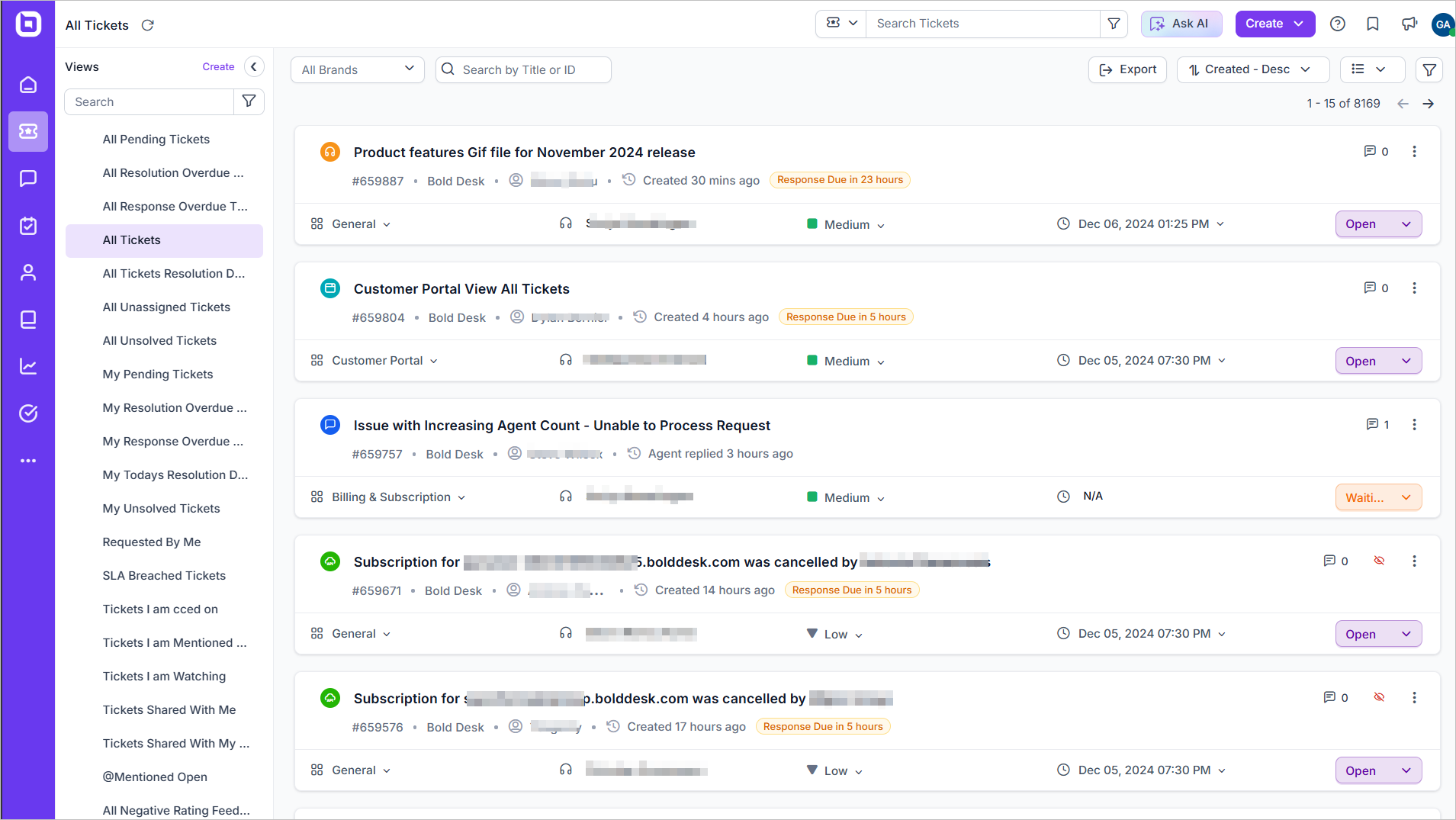
- Data collection: BoldDesk provides a highly customizable customer satisfaction survey tool that guarantees easy retrieval of feedback from clients. Users can create customized surveys with different question types and design elements.
- Data storage and security: BoldDesk organizes and stores customer data in a manner that facilitates easy information retrieval and tracking of customer issues. Having completed the SOC 2® Type 2 compliance certification, it provides top-notch security and privacy that protects user data.
- Data integration: BoldDesk offers seamless integration capabilities with your favorite applications. This helps simplify workflows, reduce data clutter, and derive insights from diverse data sets.
- Data analysis: The platform offers robust reporting and analytics tools, including customizable reports, dashboards, and visualizations, for better decision-making.
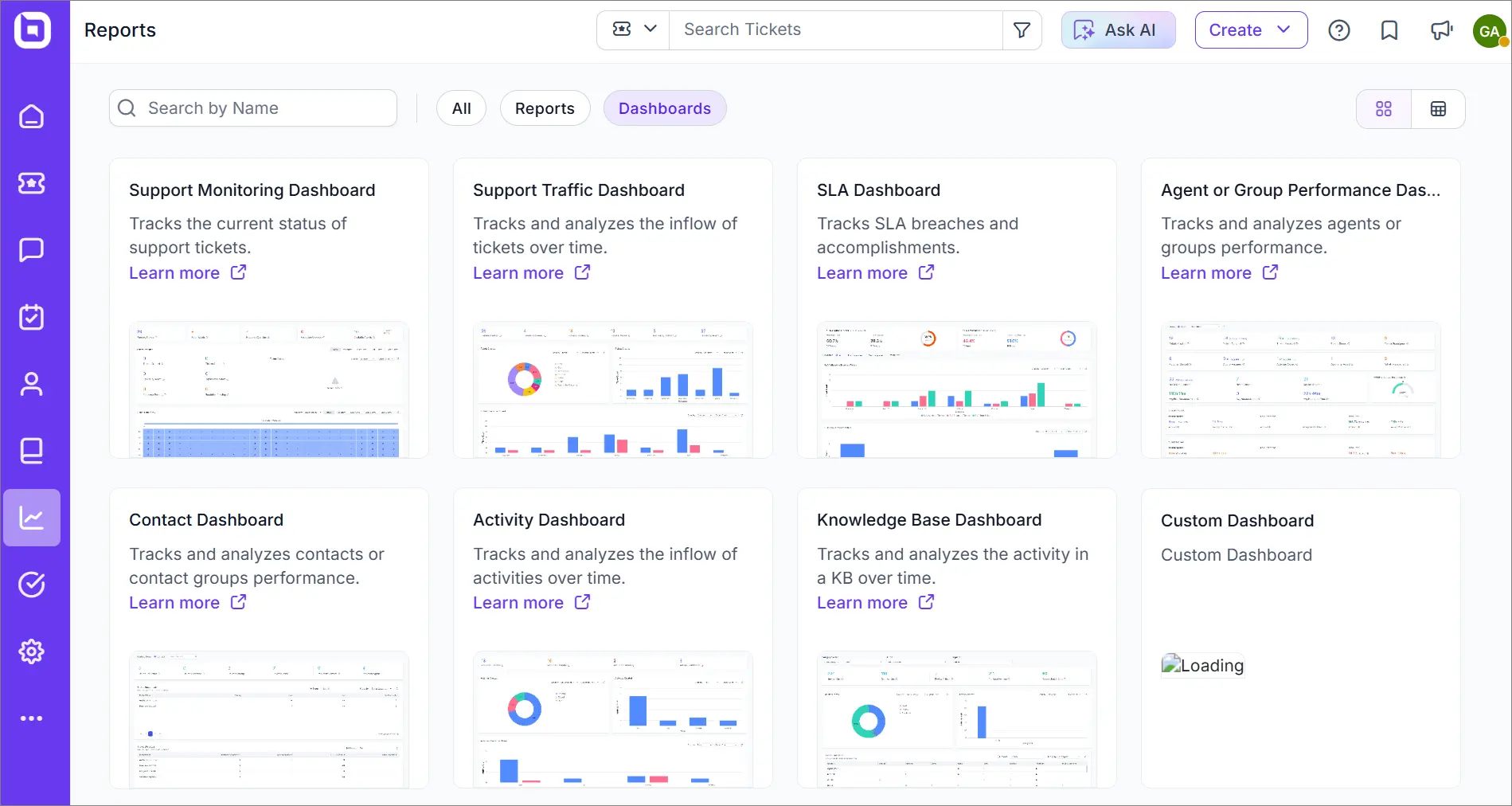
- Automation: BoldDesk provides efficient automation for repetitive and manual tasks, saving users time.
- Collaboration: BoldDesk fosters easy collaboration among team members using shared inboxes, allowing them to share reports and data visualizations with relevant stakeholders.
Elevate your business with effective customer data management
With so many new ways to collect, organize, and analyze customer information, it’s critical to have a strategy that strikes a balance between capitalizing on the data’s potential and safeguarding it from potential threats. Only then can you truly reap the benefits of your customer data.
BoldDesk is here to do the heavy lifting for you. Contact us to schedule a live demo to experience first-hand how BoldDesk’s capabilities can help you manage data efficiently. Or, try out our free trial with instant access.
Related articles
- 10 Effective Ways to Boost Your Customer Service Security
- How to Analyze Survey Data in Customer Service
- How to Create Customer Service Policies Effectively
Frequently Asked Questions
Common tools include CRM systems, help desk software (such as BoldDesk), marketing automation platforms, data analytics tools, and secure cloud-based databases.
CDM is the overall strategy and process of managing customer data, while CDP is a specific technology platform that helps implement CDM. Think of CDM as the “what and why” and CDP as the “how.”
To keep customer data secure, use end-to-end encryption, implement strict user access controls, maintain regular secure backups, and ensure compliance with standards like GDPR and SOC 2 Type 2.
Data should be continuously monitored for quality, with formal cleaning processes conducted monthly for high-volume databases and quarterly for smaller datasets. Automated validation should happen in real-time at data collection points.
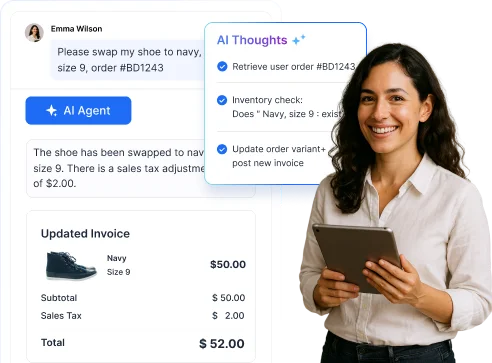


















 Email Ticketing System
Email Ticketing System Shared Inbox Software
Shared Inbox Software Multi Brand Help Desk
Multi Brand Help Desk Internal Help Desk Software
Internal Help Desk Software Trouble Ticketing Software
Trouble Ticketing Software Mobile Help Desk
Mobile Help Desk 









